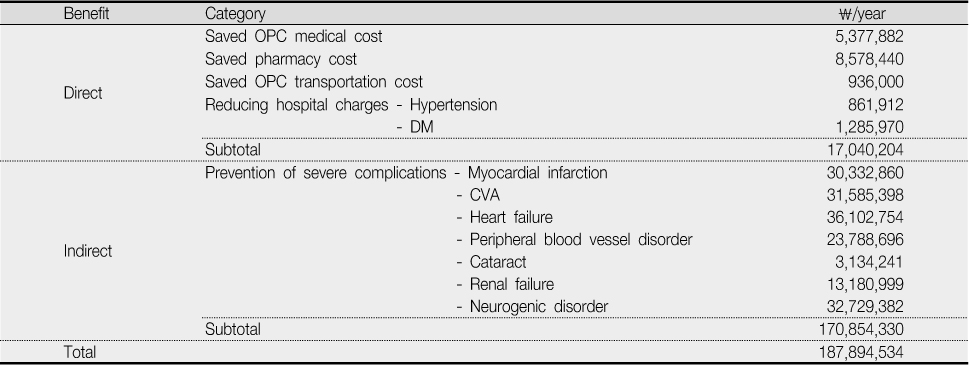1Professor, Department of Nursing, Inha University, Korea.
2Director, Gwangju City Health Center, Gyeonggi-Do, Korea.
3Lecturer, College of Nursing, Korea University, Korea.
4Market Access Director, Pfizer Korea, Korea.
Copyright © 2010 Korean Academy of Nursing Administration

*OPC=Out patient clinic;
†Patient number of OPC visit per month × Average cost of OPC per visit × Average number of OPC visit per month;
‡Patient number of pharmacy visit per month × Average pharmacy cost of pharmacy per visit × Average number of pharmacy visit per month;
§Public transportation cost per one time

*Number of reduced OPC visit per month; †Number of reduced pharmacy visit per month;
‡Number of managed hypertension patient per month × Hospital admission rate of hypertension × Average hospital charges of hypertension patient per year;
§ Number of managed DM patient per month × Hospital admission rate of DM × Average hospital charges of DM patient per year;
∥Number of managed hypertension patient per month × Severe complications rate of hypertension × Average hospital charges of severe hypertension complications per year;
¶Number of managed DM patient per month × Severe complications rate of DM × Average hospital charges of severe DM complications per year;

Characteristics of subjects* (N=101)
*Missing value excluded; †Multiple choice; ‡DM= Diabetes mellitus; §CVA=Cerebro vascular accident
∥SBP=Systolic blood pressure; ¶DBP=Diastolic blood pressure
Cost analysis of community based intensive nursing care center for elderly
*OPC=Out patient clinic;
†Patient number of OPC visit per month × Average cost of OPC per visit × Average number of OPC visit per month;
‡Patient number of pharmacy visit per month × Average pharmacy cost of pharmacy per visit × Average number of pharmacy visit per month;
§Public transportation cost per one time
Benefit analysis of community based intensive nursing care center for elderly
*Number of reduced OPC visit per month; †Number of reduced pharmacy visit per month;
‡Number of managed hypertension patient per month × Hospital admission rate of hypertension × Average hospital charges of hypertension patient per year;
§ Number of managed DM patient per month × Hospital admission rate of DM × Average hospital charges of DM patient per year;
∥Number of managed hypertension patient per month × Severe complications rate of hypertension × Average hospital charges of severe hypertension complications per year;
¶Number of managed DM patient per month × Severe complications rate of DM × Average hospital charges of severe DM complications per year;
Summary of cost-benefit analysis and sensitivity analysis
*PAR=Population attributable risk
*Missing value excluded; †Multiple choice; ‡DM= Diabetes mellitus; §CVA=Cerebro vascular accident ∥SBP=Systolic blood pressure; ¶DBP=Diastolic blood pressure
*OPC=Out patient clinic; †Patient number of OPC visit per month × Average cost of OPC per visit × Average number of OPC visit per month; ‡Patient number of pharmacy visit per month × Average pharmacy cost of pharmacy per visit × Average number of pharmacy visit per month; §Public transportation cost per one time
*Number of reduced OPC visit per month; †Number of reduced pharmacy visit per month; ‡Number of managed hypertension patient per month × Hospital admission rate of hypertension × Average hospital charges of hypertension patient per year; § Number of managed DM patient per month × Hospital admission rate of DM × Average hospital charges of DM patient per year; ∥Number of managed hypertension patient per month × Severe complications rate of hypertension × Average hospital charges of severe hypertension complications per year; ¶Number of managed DM patient per month × Severe complications rate of DM × Average hospital charges of severe DM complications per year;
*PAR=Population attributable risk